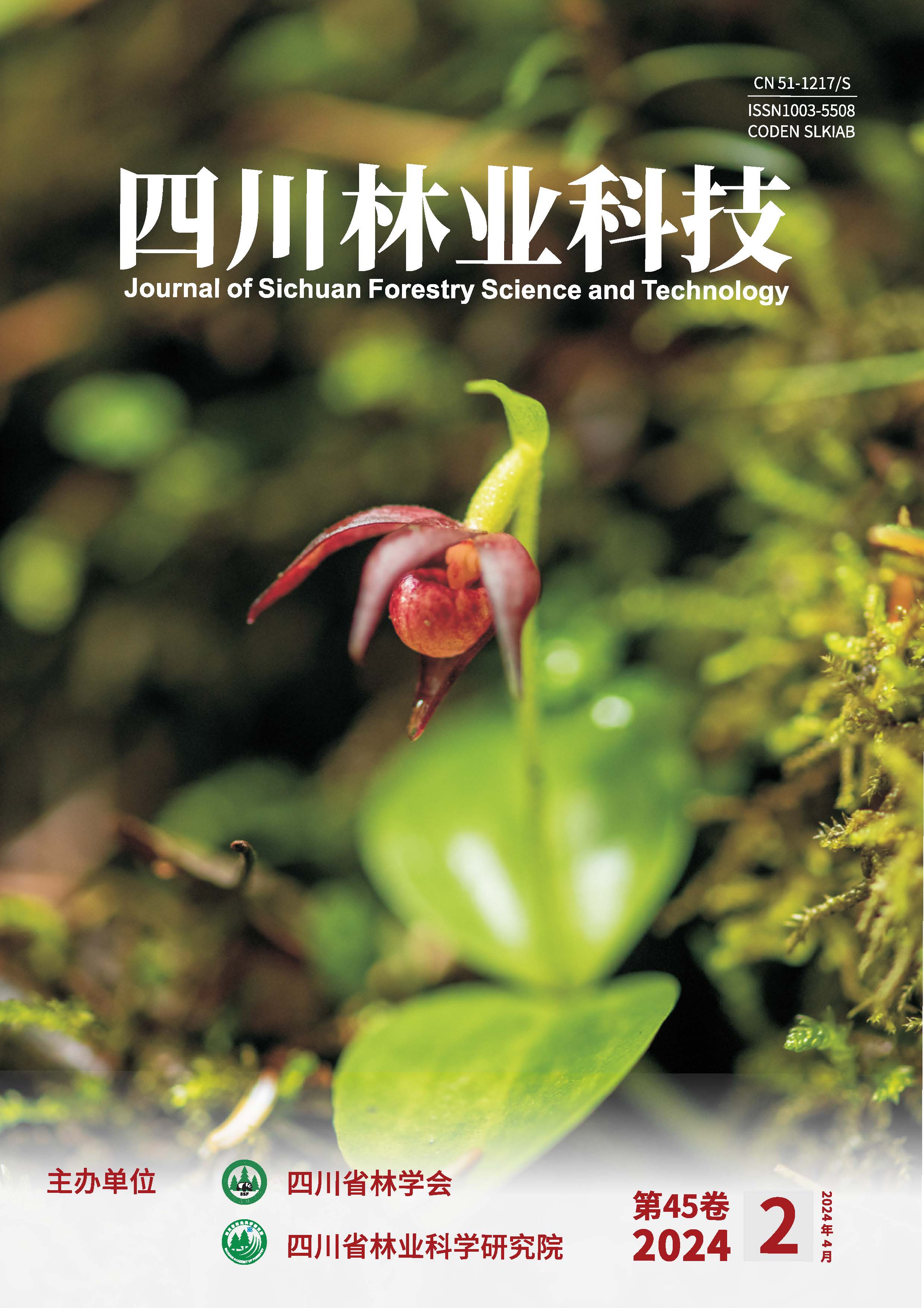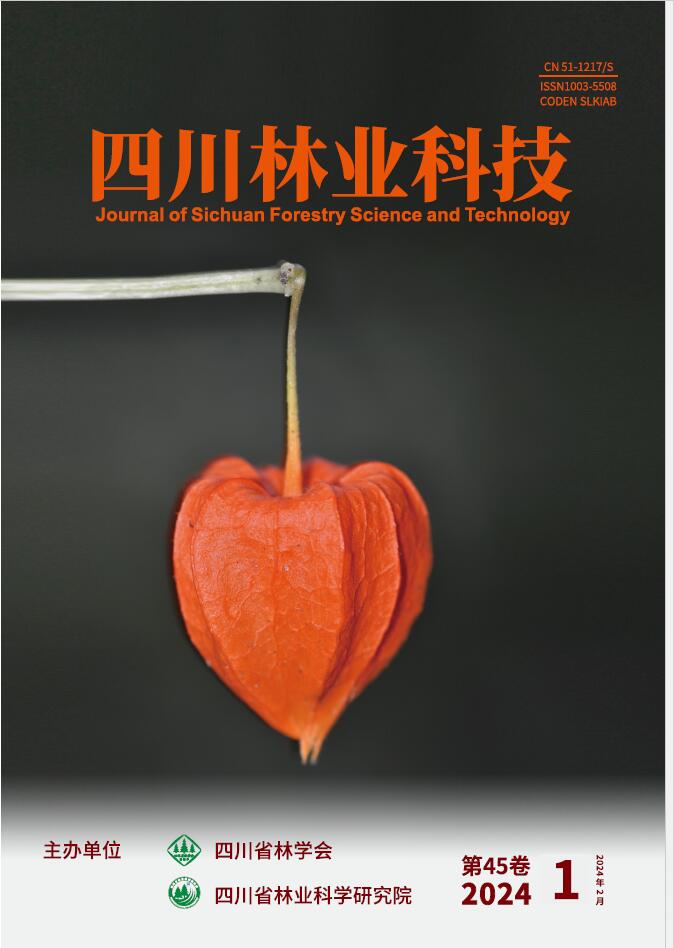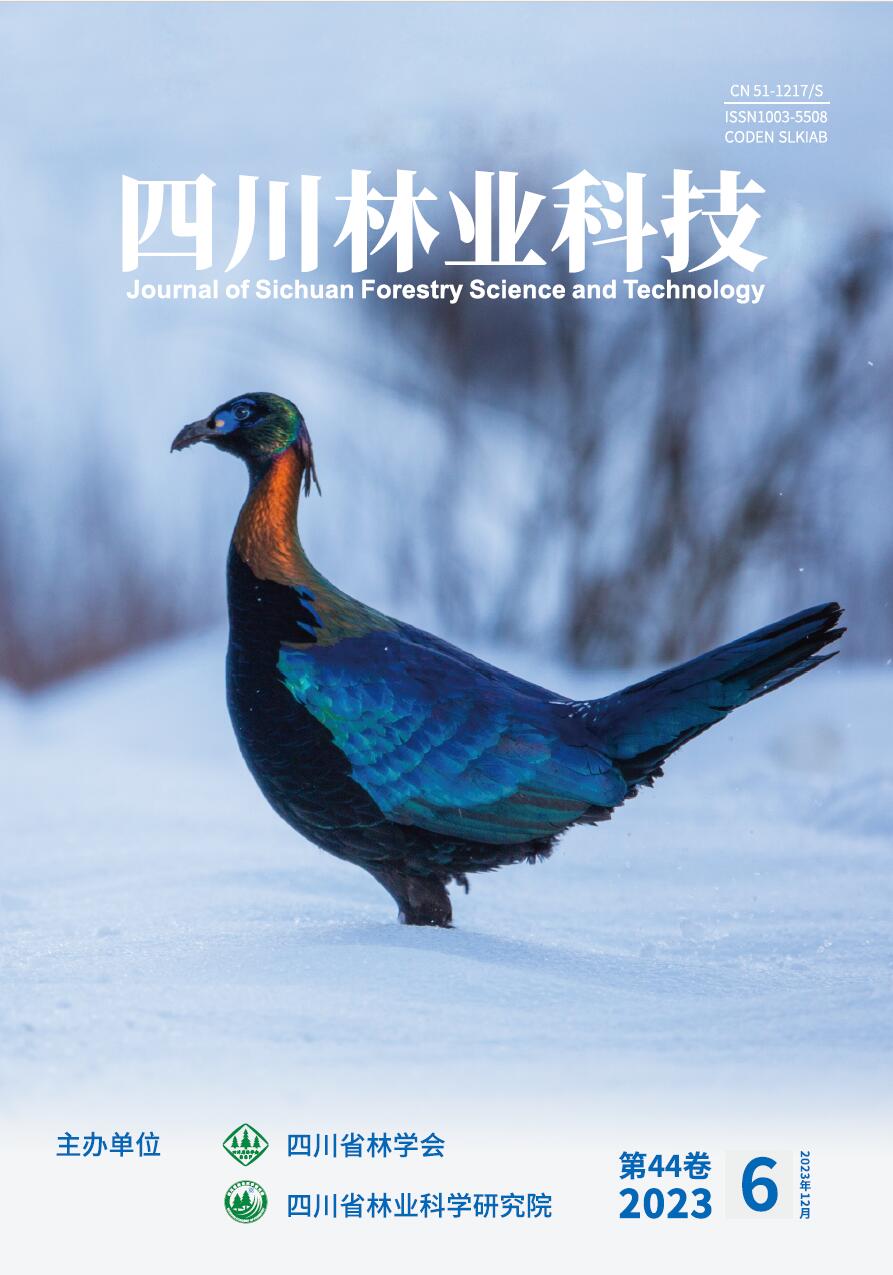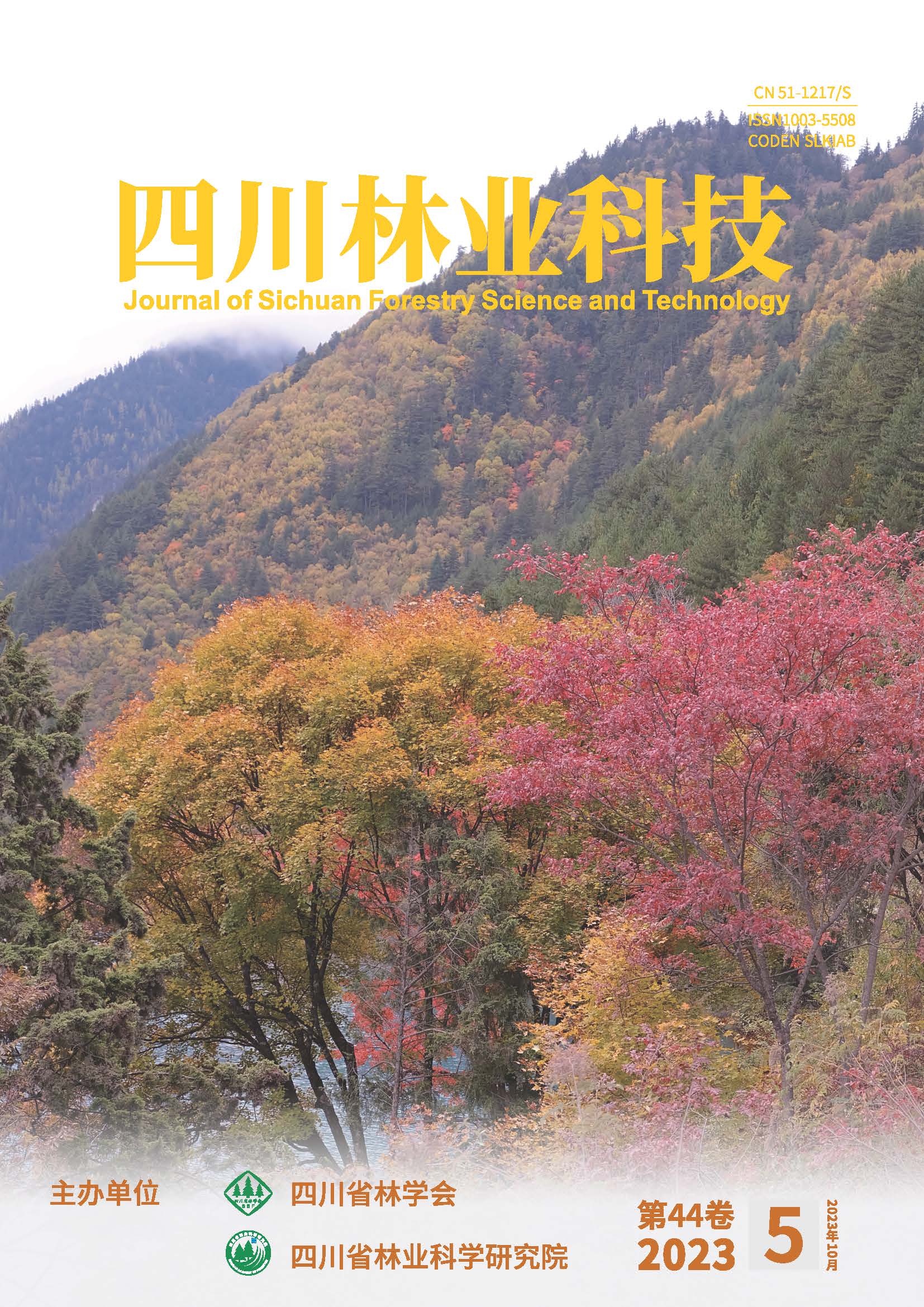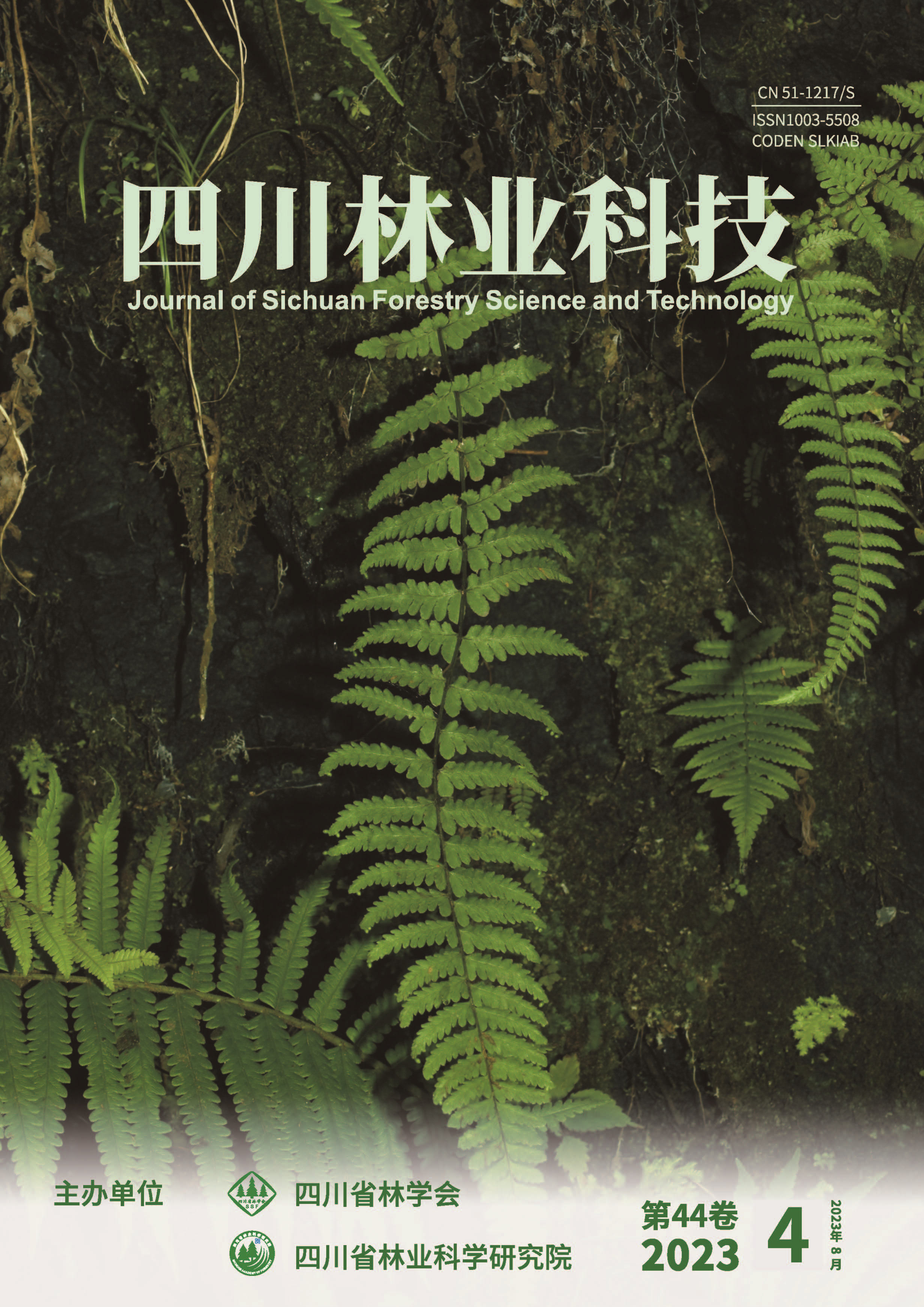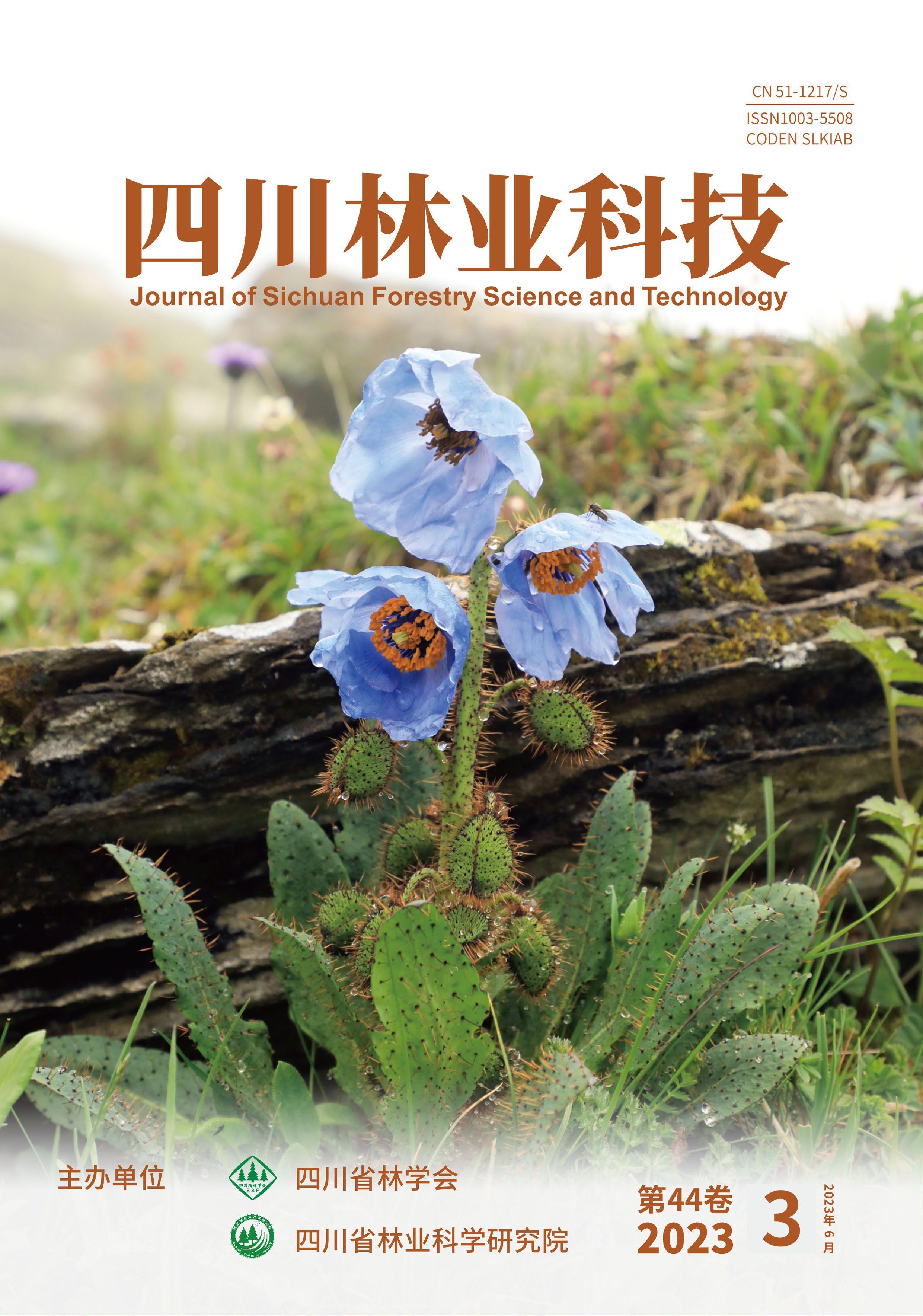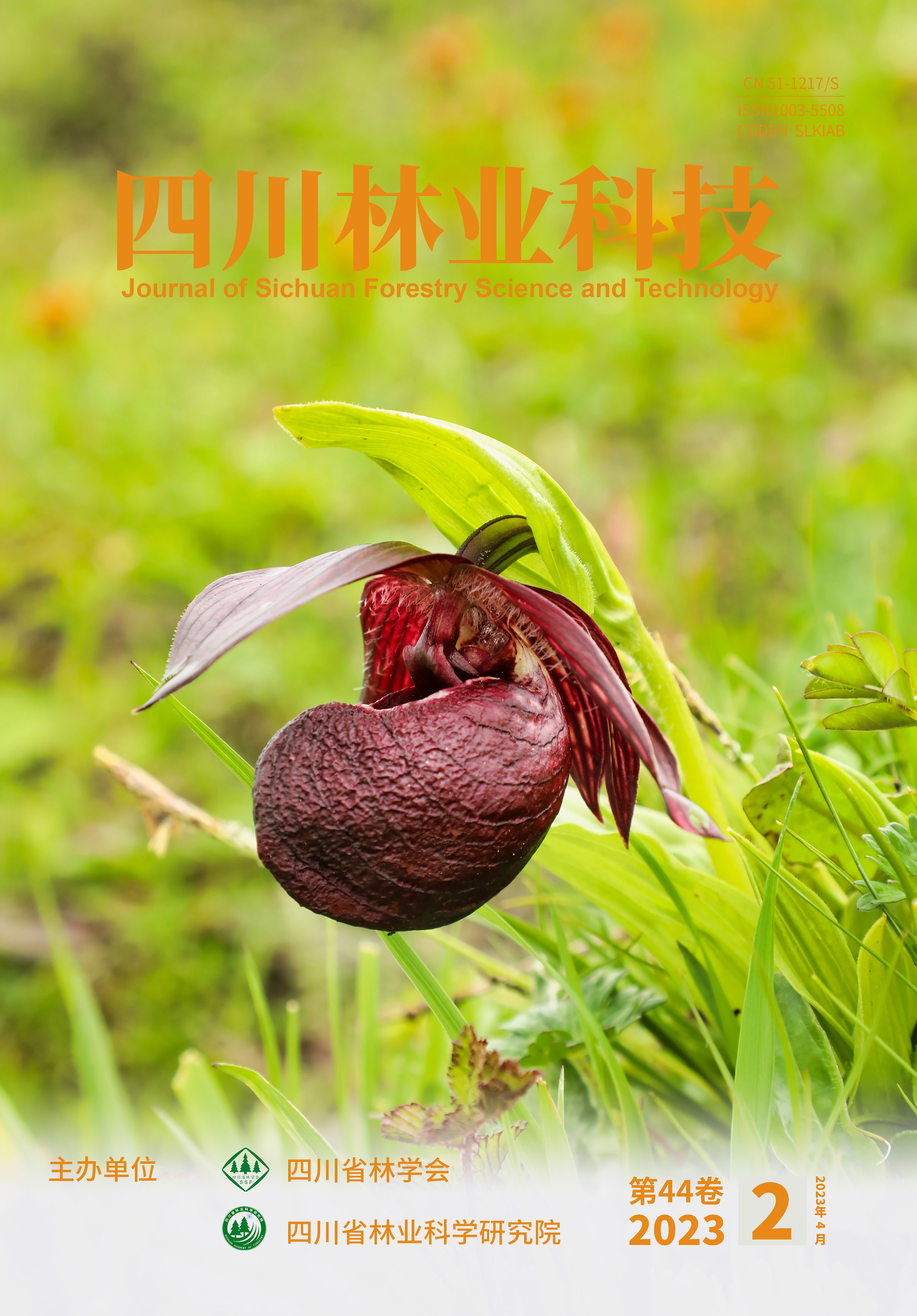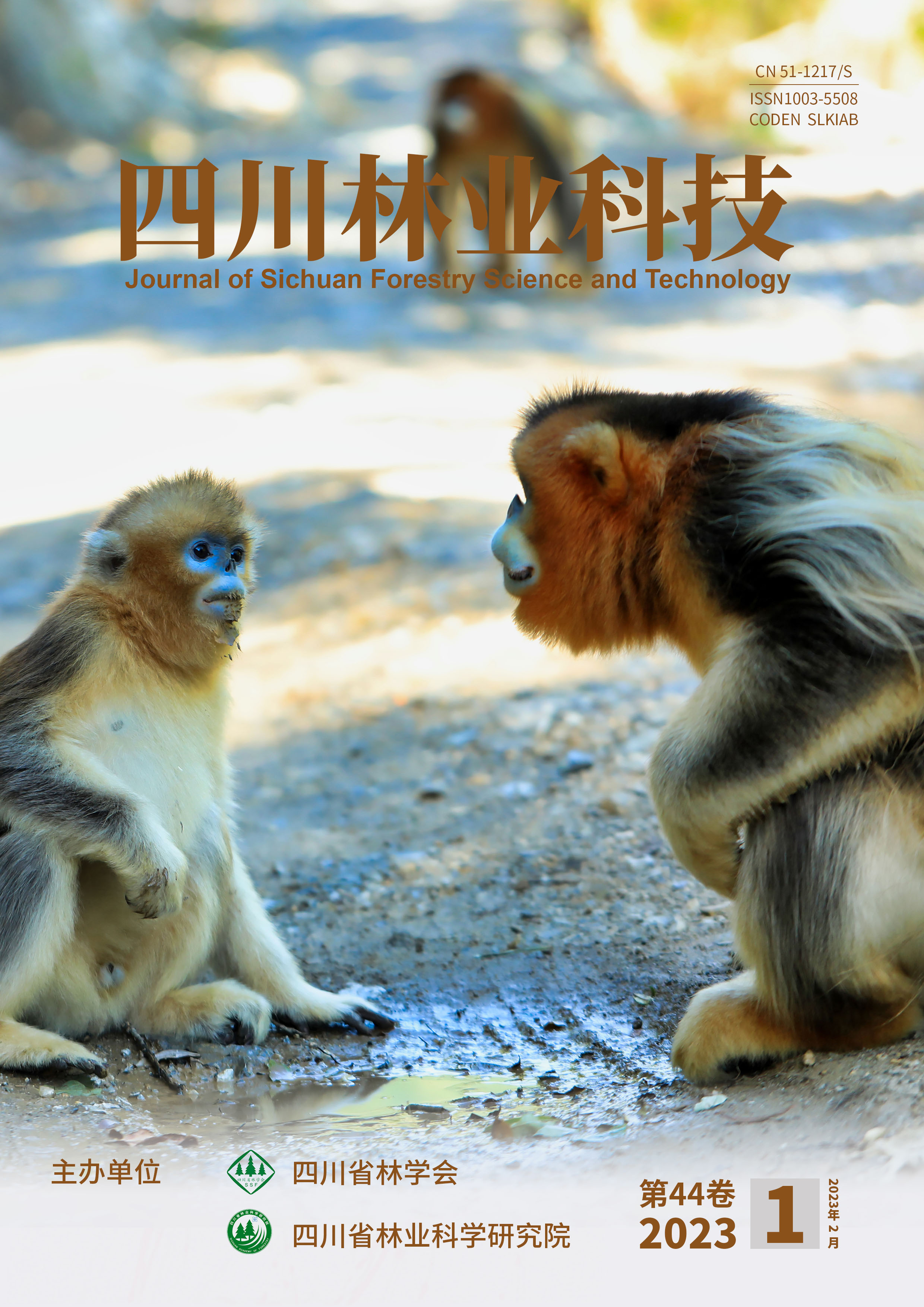2020 Vol. 41 Issue 5
2020 Vol. 41, No. 5 Catalogue
Export
Citation
2020, 41(5): 1-6.
doi: 10.12172/202004270005
Abstract:
Based on the landscape distribution map in 2012 and 2019 in the early stage of urban construction of Chengdu Tianfu New District, the landscape pattern change was studied by using the Geographic Information System (GIS) and Spatial Pattern Analysis Program for Categorical Maps (Fragstats) softwares, so as to characterize the landscape pattern changes of the focus area. The results showed that: (1) At present, the landscape composition of Tianfu New District was mainly farm land, and the forest, grassland and urban land were closely related to farm land, which was an important functional patch in the landscape. Forest, grassland and wetland patches had low proximity, poor connectivity and high fragmentation. (2) From 2012 to 2019, the area of the urban land, traffic land, forests, grasslands and wetland increased, and only the area of the farm land decreased. The functional connection of the urban and traffic land was enhanced and the aggregation degree of the traffic land increased obviously, while the proximity of the farm land decreased and the degree of the separation and fragmentation increased. (3) During the past 7 years, the characteristics of the landscape patterns of the focus area were including increases of separation, mixedness, fragmentation, diversity and evenness in landscape level. Based on the above results, some protection measures were put forward, such as constructing two parallel vegetation landscape belts, strengthening wetland network, balancing the area of the urban and farm land, and improving ecological function of the traffic land.
Based on the landscape distribution map in 2012 and 2019 in the early stage of urban construction of Chengdu Tianfu New District, the landscape pattern change was studied by using the Geographic Information System (GIS) and Spatial Pattern Analysis Program for Categorical Maps (Fragstats) softwares, so as to characterize the landscape pattern changes of the focus area. The results showed that: (1) At present, the landscape composition of Tianfu New District was mainly farm land, and the forest, grassland and urban land were closely related to farm land, which was an important functional patch in the landscape. Forest, grassland and wetland patches had low proximity, poor connectivity and high fragmentation. (2) From 2012 to 2019, the area of the urban land, traffic land, forests, grasslands and wetland increased, and only the area of the farm land decreased. The functional connection of the urban and traffic land was enhanced and the aggregation degree of the traffic land increased obviously, while the proximity of the farm land decreased and the degree of the separation and fragmentation increased. (3) During the past 7 years, the characteristics of the landscape patterns of the focus area were including increases of separation, mixedness, fragmentation, diversity and evenness in landscape level. Based on the above results, some protection measures were put forward, such as constructing two parallel vegetation landscape belts, strengthening wetland network, balancing the area of the urban and farm land, and improving ecological function of the traffic land.
2020, 41(5): 7-12.
doi: 10.12172/202005080002
Abstract:
The community species diversity of Rhododendron-Abies old-forest in the eastern Qinghai-Tibet Plateau was investigated by plot method. A total of 24 families, 31 genera and 32 species of plants were recorded, including 2 families, 3 genera and 3 species of arbor; 7 families, 8 genera, 8 species of shrubs; 21 species, 21 genera, 18 families of herbs. The dominant tree species were Abies faxoniana and Rhododendron trichogynum; the dominant shrub species were Sorbus koehneana and Ribes glaciale; the dominant herb species were Oxalis griffithii and Deyeuxia scabrescens. The species with the occurrence frequency of 81%~100% in the tree layer were the most, and the species with the occurrence frequency of 1%~20% in shrub and herb layer were the most.. The species diversity was at a low level. The Shannon-Wiener index, Species richness, and Simpson dominance index were the highest in herb species (H′ = 1.9932, S = 21, D = 0.8109), followed by shrub species (S = 8, H′ = 1.3488, D = 0.621) and lowest in tree species (S = 3, H′ = 0.8157, D = 0.5312). The Pielou evenness index of the tree layer was the highest (J = 0.743), while that of the herb layer (J = 0.655) was similar to that of the shrub layer (J = 0.649).
The community species diversity of Rhododendron-Abies old-forest in the eastern Qinghai-Tibet Plateau was investigated by plot method. A total of 24 families, 31 genera and 32 species of plants were recorded, including 2 families, 3 genera and 3 species of arbor; 7 families, 8 genera, 8 species of shrubs; 21 species, 21 genera, 18 families of herbs. The dominant tree species were Abies faxoniana and Rhododendron trichogynum; the dominant shrub species were Sorbus koehneana and Ribes glaciale; the dominant herb species were Oxalis griffithii and Deyeuxia scabrescens. The species with the occurrence frequency of 81%~100% in the tree layer were the most, and the species with the occurrence frequency of 1%~20% in shrub and herb layer were the most.. The species diversity was at a low level. The Shannon-Wiener index, Species richness, and Simpson dominance index were the highest in herb species (H′ = 1.9932, S = 21, D = 0.8109), followed by shrub species (S = 8, H′ = 1.3488, D = 0.621) and lowest in tree species (S = 3, H′ = 0.8157, D = 0.5312). The Pielou evenness index of the tree layer was the highest (J = 0.743), while that of the herb layer (J = 0.655) was similar to that of the shrub layer (J = 0.649).
2020, 41(5): 13-18.
doi: 10.12172/202007090001
Abstract:
In order to study the adaptability of economic tree species to environment of the dry valley in the upper Minjiang river, 13 physiological and biochemical indices of 11 tree species were determined. Subordinate function values analysis, grey relational analysis and clustering analysis were used to evaluate comprehensive adaptability of tree species and select evaluation indexes. The results showeded that: (1) Weight comprehensive adaptability index (WCAI) of each tree species was ranked as Amygdalus communis L. > Amygdalus tangutica (Batal.) Korsh. > Pistacia chinensis Bunge > Cotinus szechuanensis > Corylus heterophylla > Acer fabri Hance > Lycium ruthenicum Murr. > Armeniaca mume Sieb. > Hippophae rhamnoides > Juglans regia L. > Lycium chinense Mill. (2) Gs、Ci、Tr、Pnmax、SOD、CAT were closely correlated with the comprehensive adaptability of tree species, which could be used as the key evaluation indexes of economic tree species screening in the upper Minjiang river dry valley.
In order to study the adaptability of economic tree species to environment of the dry valley in the upper Minjiang river, 13 physiological and biochemical indices of 11 tree species were determined. Subordinate function values analysis, grey relational analysis and clustering analysis were used to evaluate comprehensive adaptability of tree species and select evaluation indexes. The results showeded that: (1) Weight comprehensive adaptability index (WCAI) of each tree species was ranked as Amygdalus communis L. > Amygdalus tangutica (Batal.) Korsh. > Pistacia chinensis Bunge > Cotinus szechuanensis > Corylus heterophylla > Acer fabri Hance > Lycium ruthenicum Murr. > Armeniaca mume Sieb. > Hippophae rhamnoides > Juglans regia L. > Lycium chinense Mill. (2) Gs、Ci、Tr、Pnmax、SOD、CAT were closely correlated with the comprehensive adaptability of tree species, which could be used as the key evaluation indexes of economic tree species screening in the upper Minjiang river dry valley.
2020, 41(5): 19-25.
doi: 10.12172/202003050001
Abstract:
The influence of stand density on species composition and diversity of associated plants and understory vegetation, as well as natural capacity, is the basis of studying the relationship between forest structure and function, community stability, genetic conservation and natural forests management technology. The species and quantity of all trees, shrubs and herbaceous plants in the standard plot of different stand densities were recorded by the standard plot survey method, and the diversity indexes were calculated and analyzed. At the same time, the number of natural regeneration seedlings under different density stands was recorded. The results showed that there were nine species of associated trees and 17 species of understory shrubs and herbaceous plants. The sensitivity of tree, shrub and herb species richness to the change of stand density was basically the same from the analysis of different cross degrees. From the range of species richness, trees, shrubs and herbs were more sensitive to the change of stand density. The response of understory vegetation diversity to the continuous increase of stand density was reflected as a non-single change trend. With the increase of stand density, the diversity index of stand vegetation increased at first and then decreased, showing a bimodal response pattern. In the study area, the natural spruce stands maintained a high level of understory species diversity within the density range of 400-499 ·hm-2 trees. The natural regeneration ability of Picea brachytyla natural forest was poor, and natural regeneration seedlings were found in only four density stands. Therefore, in the process of genetic conservation, the stand density should be adjusted reasonably to promote natural regeneration of Picea brachytyla natural forest.
The influence of stand density on species composition and diversity of associated plants and understory vegetation, as well as natural capacity, is the basis of studying the relationship between forest structure and function, community stability, genetic conservation and natural forests management technology. The species and quantity of all trees, shrubs and herbaceous plants in the standard plot of different stand densities were recorded by the standard plot survey method, and the diversity indexes were calculated and analyzed. At the same time, the number of natural regeneration seedlings under different density stands was recorded. The results showed that there were nine species of associated trees and 17 species of understory shrubs and herbaceous plants. The sensitivity of tree, shrub and herb species richness to the change of stand density was basically the same from the analysis of different cross degrees. From the range of species richness, trees, shrubs and herbs were more sensitive to the change of stand density. The response of understory vegetation diversity to the continuous increase of stand density was reflected as a non-single change trend. With the increase of stand density, the diversity index of stand vegetation increased at first and then decreased, showing a bimodal response pattern. In the study area, the natural spruce stands maintained a high level of understory species diversity within the density range of 400-499 ·hm-2 trees. The natural regeneration ability of Picea brachytyla natural forest was poor, and natural regeneration seedlings were found in only four density stands. Therefore, in the process of genetic conservation, the stand density should be adjusted reasonably to promote natural regeneration of Picea brachytyla natural forest.
2020, 41(5): 26-33.
doi: 10.12172/202004270003
Abstract:
In order to explore the differences of growth and photosynthetic characteristics of Phoebe zhennan saplings in three types of soil conditions (broad-leaved forest humus soil (HS), purple soil (PS), alluvial soil (AS)), 2-years-old Phoebe zhennan saplings were taken as study material, which were planted in three types of soil conditions and the saplings morphology and photosynthetic indicators were determined in May, July and October. The results showed that: (1) Phoebe zhennan saplings planted in HS had the best growth, with more growth in plant height and ground diameter, which was obviously higher than that in PS and AS, but there was no obvious difference in morphological growth between the latter two saplings; (2) The saplings planted in HS had the highest levels of chlorophyll a(Chl a), chlorophyll b(Chl b) and carotenoids (Car) content, and the overall leaf pigment content was HS > PS > AS; (3) The overall performance of net photosynthetic rate (Pn), stomatal conductance (Gs) and transpiration rate (Tr) of saplings was HS > PS > AS; (4) The light saturation point (LSP) and CO2 saturation point (CSP) of saplings in HS were higher than those of PS and AS, while the light compensation point (LCP) and CO2 compensation point (CCP) were lower than those of PS and AS, indicating that saplings planted in HS had higher photosynthetic efficiency and could accumulat more organic matter. The research showed that Phoebe zhennan saplings grown best in forest humus soil (HS), followed by purple soil (PS), and alluvial soil (AS) was the worse. In practice, it is necessary to avoid planting on alluvial soil with heavy viscosity, low porosity and poor ventilation, unless there is special need.
In order to explore the differences of growth and photosynthetic characteristics of Phoebe zhennan saplings in three types of soil conditions (broad-leaved forest humus soil (HS), purple soil (PS), alluvial soil (AS)), 2-years-old Phoebe zhennan saplings were taken as study material, which were planted in three types of soil conditions and the saplings morphology and photosynthetic indicators were determined in May, July and October. The results showed that: (1) Phoebe zhennan saplings planted in HS had the best growth, with more growth in plant height and ground diameter, which was obviously higher than that in PS and AS, but there was no obvious difference in morphological growth between the latter two saplings; (2) The saplings planted in HS had the highest levels of chlorophyll a(Chl a), chlorophyll b(Chl b) and carotenoids (Car) content, and the overall leaf pigment content was HS > PS > AS; (3) The overall performance of net photosynthetic rate (Pn), stomatal conductance (Gs) and transpiration rate (Tr) of saplings was HS > PS > AS; (4) The light saturation point (LSP) and CO2 saturation point (CSP) of saplings in HS were higher than those of PS and AS, while the light compensation point (LCP) and CO2 compensation point (CCP) were lower than those of PS and AS, indicating that saplings planted in HS had higher photosynthetic efficiency and could accumulat more organic matter. The research showed that Phoebe zhennan saplings grown best in forest humus soil (HS), followed by purple soil (PS), and alluvial soil (AS) was the worse. In practice, it is necessary to avoid planting on alluvial soil with heavy viscosity, low porosity and poor ventilation, unless there is special need.
2020, 41(5): 34-38.
doi: 10.12172/202004010001
Abstract:
In order to find out the status of the color-leafed plant resources in Yuchan Mountain and to select the species of color-leafed plants suitable for ecological landscape design, the woody color-leafed plant resources in Yuchan Mountain was investigated using the line sampling and literature review methods. The results showed that there were 187 species of woody plants belonging to 118 genera and 65 families, among which 52 species of color-leafed plants belonged to 42 genera and 31 families, accounting for 27.81% of the total species. The dominant families of color-leafed plants were Lauraceae, Fagaceae, Anacardiaceae and Sapindaceae, and trees and shrub species constituted the main body of the color-leafed plants in Yuchan Mountain. The relative frequency of Cinnamomum camphora and Mallotus barbatus was the highest. The ornamental types were mainly autumn-leafed plants, accounting for 53.85% of the total number of color-leafed plants.
In order to find out the status of the color-leafed plant resources in Yuchan Mountain and to select the species of color-leafed plants suitable for ecological landscape design, the woody color-leafed plant resources in Yuchan Mountain was investigated using the line sampling and literature review methods. The results showed that there were 187 species of woody plants belonging to 118 genera and 65 families, among which 52 species of color-leafed plants belonged to 42 genera and 31 families, accounting for 27.81% of the total species. The dominant families of color-leafed plants were Lauraceae, Fagaceae, Anacardiaceae and Sapindaceae, and trees and shrub species constituted the main body of the color-leafed plants in Yuchan Mountain. The relative frequency of Cinnamomum camphora and Mallotus barbatus was the highest. The ornamental types were mainly autumn-leafed plants, accounting for 53.85% of the total number of color-leafed plants.
2020, 41(5): 39-46.
doi: 10.12172/202008130001
Abstract:
SWOT analysis has been widely used in tourism analysis. Langzhong city, as one of the four ancient cities in china, there is still a huge development space for its tourism resources. In order to make full use of the tourism resources in Langzhong, this paper made a comprehensive analysis of the advantages, disadvantages, opportunities and challenges of the development of tourism resources in Langzhong city using investigation method and literature research method. The results showed that Langzhong tourism resources had many advantages in terms of location, government support and so on, but there were many problems in the management strategy and infrastructure. Finally, some suggestions were put forward about applying for the world cultural heritage and the establishment of related tourism routes, which can provide a strong reference for the future development of tourism in Langzhong city.
SWOT analysis has been widely used in tourism analysis. Langzhong city, as one of the four ancient cities in china, there is still a huge development space for its tourism resources. In order to make full use of the tourism resources in Langzhong, this paper made a comprehensive analysis of the advantages, disadvantages, opportunities and challenges of the development of tourism resources in Langzhong city using investigation method and literature research method. The results showed that Langzhong tourism resources had many advantages in terms of location, government support and so on, but there were many problems in the management strategy and infrastructure. Finally, some suggestions were put forward about applying for the world cultural heritage and the establishment of related tourism routes, which can provide a strong reference for the future development of tourism in Langzhong city.
2020, 41(5): 47-49.
doi: 10.12172/202004010003
Abstract:
One new record of Ericaceae species, Rhododendron campylogynum, was found in Sichuan Province. The new distribution points provided new data for discussing the geographical distribution pattern of Ericaceae species, the similarities and differences between western Sichuan and southeastern Tibet, and the chemotaxis processes from east to west.
One new record of Ericaceae species, Rhododendron campylogynum, was found in Sichuan Province. The new distribution points provided new data for discussing the geographical distribution pattern of Ericaceae species, the similarities and differences between western Sichuan and southeastern Tibet, and the chemotaxis processes from east to west.
2020, 41(5): 50-53.
doi: 10.12172/202004270004
Abstract:
Interplanting edible fungi under bamboo forest is an efficient management model in recent years, which was mainly carried out under Phyllostachys heterocycle in Jiangsu and Zhejiang provinces in the past. In order to verify the feasibility and benefits of interplanting edible fungi under bamboo forest in the cluster area of bamboo industry development in southern Sichuan, the effects of different bamboo forest types (scattered, clustered and mixed bamboo) and different stand canopy densities on the yield of Stropharia rugosannulata and Dictyophora indusiata were investigated in the planting industrial park in Wugao of Xuyong County, and the economic benefits of the interplanting model were analyzed as Phyllostachys heterocycle. The results showed that there was no significant difference in the yield of Stropharia rugosannulata and Dictyophora indusiata under different bamboo forests, but the canopy density had a significant impact on it, among which Stropharia rugosannulata had the highest yield at 0.7~0.75 and Dictyophora indusiata had the highest yield at 0.8~0.85. The net income of interplanting Stropharia rugosannulata and Dictyophora indusiata under Phyllostachys heterocycle forest was as high as 105779 and 16395 yuan per hectare, which were 19.6 and 30.4 times higher than that of Phyllostachys heterocycle monoculture, repectively. Bamboo-fungi interplanting model combines bamboo and edible fungi, which is a circular economy model with resource sharing, complementary advantages and strong feasibility.
Interplanting edible fungi under bamboo forest is an efficient management model in recent years, which was mainly carried out under Phyllostachys heterocycle in Jiangsu and Zhejiang provinces in the past. In order to verify the feasibility and benefits of interplanting edible fungi under bamboo forest in the cluster area of bamboo industry development in southern Sichuan, the effects of different bamboo forest types (scattered, clustered and mixed bamboo) and different stand canopy densities on the yield of Stropharia rugosannulata and Dictyophora indusiata were investigated in the planting industrial park in Wugao of Xuyong County, and the economic benefits of the interplanting model were analyzed as Phyllostachys heterocycle. The results showed that there was no significant difference in the yield of Stropharia rugosannulata and Dictyophora indusiata under different bamboo forests, but the canopy density had a significant impact on it, among which Stropharia rugosannulata had the highest yield at 0.7~0.75 and Dictyophora indusiata had the highest yield at 0.8~0.85. The net income of interplanting Stropharia rugosannulata and Dictyophora indusiata under Phyllostachys heterocycle forest was as high as 105779 and 16395 yuan per hectare, which were 19.6 and 30.4 times higher than that of Phyllostachys heterocycle monoculture, repectively. Bamboo-fungi interplanting model combines bamboo and edible fungi, which is a circular economy model with resource sharing, complementary advantages and strong feasibility.
2020, 41(5): 54-59.
doi: 10.12172/202004210001
Abstract:
In order to improve the yield and quality of Zanthoxylum armatum, the pruning methods were explored. In this experiment, the effects of different pruning methods on growth, yield and quality of Zanthoxylum armatum were studied. Compared with the CK, the tree height and crown width of CPP and TP were significantly reduced by 36.8% and 12.0%, 22% and 16.7%, respectively; the branche number, fruit setting rate, fresh pepper yield, pepper peel yield and peel rate were increased by 32.7% and 16.4%, 10.3% and 7.6%, 52.3% and 40.7%, 64.2% and 44.7%, 7.9% and 2.6%, respectively; the thousand pepper weight, numb taste components, volatile oil, ethanol soluble extract and non-volatile ether extract contents were increased by 18.0% and 17.1%, 10.0% and 7.9%, 8.6% and 5.5%, 12.9% and 8.5%, respectively. The comprehensive values of yield and quality of Zanthoxylum armatum were ranked as CPP > TP > CK. The results showed that CPP was an effective pruning methods for Zanthoxylum armatum to control the height and crown width, promote the growth of branches and shoots and improve the yield and quality.
In order to improve the yield and quality of Zanthoxylum armatum, the pruning methods were explored. In this experiment, the effects of different pruning methods on growth, yield and quality of Zanthoxylum armatum were studied. Compared with the CK, the tree height and crown width of CPP and TP were significantly reduced by 36.8% and 12.0%, 22% and 16.7%, respectively; the branche number, fruit setting rate, fresh pepper yield, pepper peel yield and peel rate were increased by 32.7% and 16.4%, 10.3% and 7.6%, 52.3% and 40.7%, 64.2% and 44.7%, 7.9% and 2.6%, respectively; the thousand pepper weight, numb taste components, volatile oil, ethanol soluble extract and non-volatile ether extract contents were increased by 18.0% and 17.1%, 10.0% and 7.9%, 8.6% and 5.5%, 12.9% and 8.5%, respectively. The comprehensive values of yield and quality of Zanthoxylum armatum were ranked as CPP > TP > CK. The results showed that CPP was an effective pruning methods for Zanthoxylum armatum to control the height and crown width, promote the growth of branches and shoots and improve the yield and quality.
2020, 41(5): 60-65.
doi: 10.12172/202003190002
Abstract:
In this paper, six primary selected one-year-old seedlings of Zanthoxylum L. were selected as experimental material, and the growth rate, plasma membrane permeability, relative water content of leaves and damage of plants of the root stocks under different drought treatments were measured by pot experiment. The drought resistance of the six rootstocks was comprehensively evaluated by membership function method. The results showed that: Chuan Zhi-3, a wild material of Zanthoxylum L., showed relatively little changes in growth and relative water content of leaves, little change in plasma membrane permeability, and mild drought symptoms duting the whole drought stress process, indicating that its drought resistance was significantly better than other candidate materials.
In this paper, six primary selected one-year-old seedlings of Zanthoxylum L. were selected as experimental material, and the growth rate, plasma membrane permeability, relative water content of leaves and damage of plants of the root stocks under different drought treatments were measured by pot experiment. The drought resistance of the six rootstocks was comprehensively evaluated by membership function method. The results showed that: Chuan Zhi-3, a wild material of Zanthoxylum L., showed relatively little changes in growth and relative water content of leaves, little change in plasma membrane permeability, and mild drought symptoms duting the whole drought stress process, indicating that its drought resistance was significantly better than other candidate materials.
2020, 41(5): 66-71.
doi: 10.12172/202005120001
Abstract:
Juglans regia L. is one of the most important economic species in China. In order to make early selection of hybrid offspring and predict production effects, and provide reference for enriching the theory of woody hybrid breeding and reducing the risk of production popularization and application. In this experiment, "Chuanzao 1" was used as the female parent to conduct controlled pollination experiments, and the growth indicators and photosynthetic physiological parameters of senven F1 generations were compared. The results showed that: the coefficient of variation of phenotypic traits among F1 generations was wide (3.25%—23.67%), especially the coefficient of variation of single fruit weight was the largest, reaching 23.67%.The Chlorophyll variance analysis showed that there was extreme significant difference among the 21 hybrid nuts (8.373**), and the CV of chlorophyll was 29.66%. The C1GC had great photosynthetic potential. The principal component analysis showed that the extracted first three principal components covered 87.066% of all characters, and the first three excellent F1 generations were C1GC (1.5650), C1SL (0.9884) and C1ZF (0.4559). Howerer, considering that the parthenogenesis would have a lower emergence rate, the superior Juglans regia seedlings were C1SL and C1ZF.
Juglans regia L. is one of the most important economic species in China. In order to make early selection of hybrid offspring and predict production effects, and provide reference for enriching the theory of woody hybrid breeding and reducing the risk of production popularization and application. In this experiment, "Chuanzao 1" was used as the female parent to conduct controlled pollination experiments, and the growth indicators and photosynthetic physiological parameters of senven F1 generations were compared. The results showed that: the coefficient of variation of phenotypic traits among F1 generations was wide (3.25%—23.67%), especially the coefficient of variation of single fruit weight was the largest, reaching 23.67%.The Chlorophyll variance analysis showed that there was extreme significant difference among the 21 hybrid nuts (8.373**), and the CV of chlorophyll was 29.66%. The C1GC had great photosynthetic potential. The principal component analysis showed that the extracted first three principal components covered 87.066% of all characters, and the first three excellent F1 generations were C1GC (1.5650), C1SL (0.9884) and C1ZF (0.4559). Howerer, considering that the parthenogenesis would have a lower emergence rate, the superior Juglans regia seedlings were C1SL and C1ZF.
2020, 41(5): 72-75.
doi: 10.12172/202004070003
Abstract:
Tending and transforation of man-made forest is an important forest practice to accurately improve forest quality. In order to evaluate the effects of tending and transformation on the low yield and low efficiency forest of high-density Pinus armandii, the high-density Pinus armandii with low-yield and low-efficiency plantation in Group 5, jian shan village, Taiping Town, Huili County was transformed. The growth of trees, the change of stand fruit setting, the impact of biodiversity, water and soil conservation were investigated after six years of low-efficiency stand transformation. The results showed that the thinning and tending of the low-yield and low-efficiency Pinus armandii plantation could not only promote the growth quality of Pinus armandii stands, but also increased the seed yield of Pinus armandii by at least 3.5 times in a short period of time, and promoted the forest biodiversity and soil and water conservation capacity.
Tending and transforation of man-made forest is an important forest practice to accurately improve forest quality. In order to evaluate the effects of tending and transformation on the low yield and low efficiency forest of high-density Pinus armandii, the high-density Pinus armandii with low-yield and low-efficiency plantation in Group 5, jian shan village, Taiping Town, Huili County was transformed. The growth of trees, the change of stand fruit setting, the impact of biodiversity, water and soil conservation were investigated after six years of low-efficiency stand transformation. The results showed that the thinning and tending of the low-yield and low-efficiency Pinus armandii plantation could not only promote the growth quality of Pinus armandii stands, but also increased the seed yield of Pinus armandii by at least 3.5 times in a short period of time, and promoted the forest biodiversity and soil and water conservation capacity.
2020, 41(5): 76-80.
doi: 10.12172/202003240002
Abstract:
In order to explore the technologies of establishment scion plucking orchard and cutting seedling propagation skills on Zanthoxylum armatum ‘Tengjiao’, the data was collected in a trial arranged different treatments. The results showed that: (1) The rooting rate of cuttings soaked in 400 mg·L−1 GGR1 rooting powder water solution was the highest, reaching 66.97%, while the cuttings treated with clear water had the worst effect, with the rooting rate of 21.1%. (2) The best cutting effect was in February and late November, and the survival rate was 84.1%~88.7%. The poor cutting effect was in May and late August, and the survival rate was 22.5%~36.2%. (3) The best cutting effect was to keep half leaves in summer, and the rooting rate was 43.7%.
In order to explore the technologies of establishment scion plucking orchard and cutting seedling propagation skills on Zanthoxylum armatum ‘Tengjiao’, the data was collected in a trial arranged different treatments. The results showed that: (1) The rooting rate of cuttings soaked in 400 mg·L−1 GGR1 rooting powder water solution was the highest, reaching 66.97%, while the cuttings treated with clear water had the worst effect, with the rooting rate of 21.1%. (2) The best cutting effect was in February and late November, and the survival rate was 84.1%~88.7%. The poor cutting effect was in May and late August, and the survival rate was 22.5%~36.2%. (3) The best cutting effect was to keep half leaves in summer, and the rooting rate was 43.7%.
2020, 41(5): 81-85.
doi: 10.12172/202004270002
Abstract:
According to the technical problems of long seedling growth cycle, low seedling emergence rate and irregular seedling emergence of Paris polyphylla, the effects of different germination methods, seedling growing substrate and seed size on seed germination rate were explored, which could provide reference for rapid seedling growth of Paris polyphylla.The results showed that the germination rate and germination time were significantly affected by germination accelerating method and seedling growing substrate, but the germination time was not significantly affected by seed size. Among all the treatment, the seeds treated by double-low and double-high alternate temperature method were sown with humus soil, coconut brick and sand mixed substrate, which had the best seedling raising effect, with shortened germination time and improved germination rate. The germination time was only about 120 days, the germination rate was as high as 82%, the emergence time was short, the seedling rate was high, and the emergence was neat.
According to the technical problems of long seedling growth cycle, low seedling emergence rate and irregular seedling emergence of Paris polyphylla, the effects of different germination methods, seedling growing substrate and seed size on seed germination rate were explored, which could provide reference for rapid seedling growth of Paris polyphylla.The results showed that the germination rate and germination time were significantly affected by germination accelerating method and seedling growing substrate, but the germination time was not significantly affected by seed size. Among all the treatment, the seeds treated by double-low and double-high alternate temperature method were sown with humus soil, coconut brick and sand mixed substrate, which had the best seedling raising effect, with shortened germination time and improved germination rate. The germination time was only about 120 days, the germination rate was as high as 82%, the emergence time was short, the seedling rate was high, and the emergence was neat.
2020, 41(5): 86-89.
doi: 10.12172/202003170001
Abstract:
Taking forest land management in Panzhihua City as the research object, the data of forest resources in recent five years were collected, and the increase amount (forest coverage rate, forest volume) and the decrease amount (forest land use, forest harvesting) were selected for comparative analysis of forest land management effectiveness. Combined with the structure of forest resources, available space and other aspects, the countermeasures of future forest land management were put forward in order to provide important theoretical support for forest resources management.
Taking forest land management in Panzhihua City as the research object, the data of forest resources in recent five years were collected, and the increase amount (forest coverage rate, forest volume) and the decrease amount (forest land use, forest harvesting) were selected for comparative analysis of forest land management effectiveness. Combined with the structure of forest resources, available space and other aspects, the countermeasures of future forest land management were put forward in order to provide important theoretical support for forest resources management.
2020, 41(5): 90-93.
doi: 10.12172/202004270001
Abstract:
In view of the technical problems such as long seedling breeding cycle, low seedling emergence rate and irregular seedling emergence of Euscaphis japonica seed, effects of different ways of accelerating germination and storage media on seed germination rate were explored in order to provide reference for efficient seedling breeding of Euscaphis japonica. The results showed that the most suitable seed germination treatment was soaking at 50 ℃, soaking time was 72 hours and GA3 concentration was 500 mg/L. The most suitable storage conditions were air-dried in natural environment.
In view of the technical problems such as long seedling breeding cycle, low seedling emergence rate and irregular seedling emergence of Euscaphis japonica seed, effects of different ways of accelerating germination and storage media on seed germination rate were explored in order to provide reference for efficient seedling breeding of Euscaphis japonica. The results showed that the most suitable seed germination treatment was soaking at 50 ℃, soaking time was 72 hours and GA3 concentration was 500 mg/L. The most suitable storage conditions were air-dried in natural environment.
2020, 41(5): 94-104.
doi: 10.12172/202005090001
Abstract:
Dwarf bamboos are the main food resources for the giant panda, which are the basis for the survival and reproduction of the giant panda. The research on the giant panda’s staple diet is of great significance for the protection of the giant panda. In this study, the staple food bamboo of the giant panda in Baishuihe National Nature Reserve was taken as the research object, and the species, population characteristics and environmental factors of staple food bamboo were stuied by sample line and quadrat method. The results were as follows: (1) There were 7 bamboo species in Baishuihe National Nature Reserve, including White bamboo clip (Phyllostachys bissetii), Thorn black bamboo (Chimonobambusa neopurpurea), Bamboo with short cone (Yushania brevipaniculata), broadleaf bamboo (Indocalamus longiauritus), cold arrow bamboo (Bashania fangiana), Bamboo stick (Fargesia robusta), Twigs arrow bamboo (F. stenoclada), which were mainly distributed below 3000 m above sea level and grown well by cloning. (2) Among the 7 bamboo species, the quadrat ratio of 1-year-old clonal ramets was 47.1%−100%, the quadrat ratio of 1-year-old clonal ramets per unit area was 7.5%−25.9%, and the quadrat ratio of bamboo death was 23.5%−100%. (3) The density range of clonal ramets of 7 bamboo species was 14.5−48.8 /m2, among which the density range of 1-year-old clonal ramets was 2−6/m2. (4) The average diameter of clonal ramets of 7 bamboo species was 5.2−8.4 mm, and the average height was 110.9−189.0 cm. (5) Altitude only had a significant effect on the density of cold arrow bamboo (P<0.05), but had no significant impact on the density of the other 6 bamboo species (P>0.05). (6) The canopy density only had a significant effect on the density, basal diameter and height of Twigs arrow bamboos (P<0.01), but had no significant effect on the other 6 bamboo species (P>0.05). (7) Giant panda mainly feed on short cone Yushan bamboo and Twigs arrow bamboo, which were widely distributed and less affected by slope and aspect. It’s suggested that the short cone Yushan bamboo and Twigs arrow bamboo should be replanted properly in the habitat and potential habitat of the giant panda, in order to form mixed bamboo forests with different ages and multiple bamboo species.
Dwarf bamboos are the main food resources for the giant panda, which are the basis for the survival and reproduction of the giant panda. The research on the giant panda’s staple diet is of great significance for the protection of the giant panda. In this study, the staple food bamboo of the giant panda in Baishuihe National Nature Reserve was taken as the research object, and the species, population characteristics and environmental factors of staple food bamboo were stuied by sample line and quadrat method. The results were as follows: (1) There were 7 bamboo species in Baishuihe National Nature Reserve, including White bamboo clip (Phyllostachys bissetii), Thorn black bamboo (Chimonobambusa neopurpurea), Bamboo with short cone (Yushania brevipaniculata), broadleaf bamboo (Indocalamus longiauritus), cold arrow bamboo (Bashania fangiana), Bamboo stick (Fargesia robusta), Twigs arrow bamboo (F. stenoclada), which were mainly distributed below 3000 m above sea level and grown well by cloning. (2) Among the 7 bamboo species, the quadrat ratio of 1-year-old clonal ramets was 47.1%−100%, the quadrat ratio of 1-year-old clonal ramets per unit area was 7.5%−25.9%, and the quadrat ratio of bamboo death was 23.5%−100%. (3) The density range of clonal ramets of 7 bamboo species was 14.5−48.8 /m2, among which the density range of 1-year-old clonal ramets was 2−6/m2. (4) The average diameter of clonal ramets of 7 bamboo species was 5.2−8.4 mm, and the average height was 110.9−189.0 cm. (5) Altitude only had a significant effect on the density of cold arrow bamboo (P<0.05), but had no significant impact on the density of the other 6 bamboo species (P>0.05). (6) The canopy density only had a significant effect on the density, basal diameter and height of Twigs arrow bamboos (P<0.01), but had no significant effect on the other 6 bamboo species (P>0.05). (7) Giant panda mainly feed on short cone Yushan bamboo and Twigs arrow bamboo, which were widely distributed and less affected by slope and aspect. It’s suggested that the short cone Yushan bamboo and Twigs arrow bamboo should be replanted properly in the habitat and potential habitat of the giant panda, in order to form mixed bamboo forests with different ages and multiple bamboo species.
2020, 41(5): 105-110.
doi: 10.12172/202007030002
Abstract:
As one of the most important food resources for Ailuropoda melanoleuca in Minshan Mountains, the edibility study of Fargesia denudata is the key to evaluate the nutritional status and palatability for A. melanoleuca. In order to reveal the effects of different light intensity on the nutritional contents and palatability of F. denudata, the edible contents in its shoots, stems and leaves of F. denudata, which grown in natural forest understory, forest edge and forest gap in Wang Lang National Nature Reserve, Sichuan Province, were analyzed. The results were as follows: (1) the low light intensity environment in forest understory was beneficial for the accumulation of total phenols in the bamboo shoots, but unbeneficial for the accumulation of crude protein, crude fat and total amino acids. It was beneficial for the accumulation of crude protein, crude fat, total amino acids in stems, but unbeneficial for the accumulation of cellulose. It was beneficial for the accumulation of total amino acids, cellulose in leaves, but unbeneficial for the accumulation of crude protein and tannin. (2) The middle medium light intensity environment in forest gap was beneficial for the accumulation of crude fat, total amino acids in shoots of F. denudata, but unbeneficial for the accumulation of crude protein in stems and leaves, and unbeneficial for the accumulation of crude protein, cellulose and total phenols in leaves. (3) The high light intensity environment in forest gap was beneficial for the accumulation of crude protein in the bamboo shoots, and unbeneficial for the accumulation of total amino acids, total phenols. It is beneficial for the accumulation of cellulose in stems, and unbeneficial for the accumulation of crude protein, crude fat, total amino acids. It is beneficial for the accumulation of crude protein, tannin, total phenols in leaves, and unbeneficial for the accumulation of total amino acids, cellulose. These results indicated that different light intensity had different effects on the edible contents in shoots, stems and leaves of F. denudata. It would be advisable to increase the comparative study of different bamboo species, different organs and different microenvironment in the the edible bamboo studies for A. melanoleuca, which may enrich the research content of edible bamboo species in different growth environments.
As one of the most important food resources for Ailuropoda melanoleuca in Minshan Mountains, the edibility study of Fargesia denudata is the key to evaluate the nutritional status and palatability for A. melanoleuca. In order to reveal the effects of different light intensity on the nutritional contents and palatability of F. denudata, the edible contents in its shoots, stems and leaves of F. denudata, which grown in natural forest understory, forest edge and forest gap in Wang Lang National Nature Reserve, Sichuan Province, were analyzed. The results were as follows: (1) the low light intensity environment in forest understory was beneficial for the accumulation of total phenols in the bamboo shoots, but unbeneficial for the accumulation of crude protein, crude fat and total amino acids. It was beneficial for the accumulation of crude protein, crude fat, total amino acids in stems, but unbeneficial for the accumulation of cellulose. It was beneficial for the accumulation of total amino acids, cellulose in leaves, but unbeneficial for the accumulation of crude protein and tannin. (2) The middle medium light intensity environment in forest gap was beneficial for the accumulation of crude fat, total amino acids in shoots of F. denudata, but unbeneficial for the accumulation of crude protein in stems and leaves, and unbeneficial for the accumulation of crude protein, cellulose and total phenols in leaves. (3) The high light intensity environment in forest gap was beneficial for the accumulation of crude protein in the bamboo shoots, and unbeneficial for the accumulation of total amino acids, total phenols. It is beneficial for the accumulation of cellulose in stems, and unbeneficial for the accumulation of crude protein, crude fat, total amino acids. It is beneficial for the accumulation of crude protein, tannin, total phenols in leaves, and unbeneficial for the accumulation of total amino acids, cellulose. These results indicated that different light intensity had different effects on the edible contents in shoots, stems and leaves of F. denudata. It would be advisable to increase the comparative study of different bamboo species, different organs and different microenvironment in the the edible bamboo studies for A. melanoleuca, which may enrich the research content of edible bamboo species in different growth environments.
2020, 41(5): 111-115.
doi: 10.12172/202004300002
Abstract:
The food habits of sambar deer, an animal accompanied with the giant panda, were analyzed for six months by means of microscopic image analysis of feces in Wuyi Shed, Wolong National Nature Reserve. The results showed that sambar deer had the habit of eating bamboo leaves, and the amount of bamboo leaves they consumed changed with the season. When the food was abundant, they ofen feed on woody leaves and dicotyledonous herbs, and the proportion of bamboo leaves was relatively low. With the advent of winter, the food resources were reduced, the sambar deer would gradually increase their dependence on bamboo leaves, especially in February with thick snow. The relative density of bamboo leaves residues in feces was as high as 91.82%. At least in winter, the feeding activities of sambar deer establisded the food competition relationship with giant pandas. Effective management and control of sambar deer density is one of the measures to be considered in the habitat protection of giant pandas.
The food habits of sambar deer, an animal accompanied with the giant panda, were analyzed for six months by means of microscopic image analysis of feces in Wuyi Shed, Wolong National Nature Reserve. The results showed that sambar deer had the habit of eating bamboo leaves, and the amount of bamboo leaves they consumed changed with the season. When the food was abundant, they ofen feed on woody leaves and dicotyledonous herbs, and the proportion of bamboo leaves was relatively low. With the advent of winter, the food resources were reduced, the sambar deer would gradually increase their dependence on bamboo leaves, especially in February with thick snow. The relative density of bamboo leaves residues in feces was as high as 91.82%. At least in winter, the feeding activities of sambar deer establisded the food competition relationship with giant pandas. Effective management and control of sambar deer density is one of the measures to be considered in the habitat protection of giant pandas.
2020, 41(5): 116-120.
doi: 10.12172/201912120003
Abstract:
The wild macrofungi of Wanglang National Nature Reserve was investigated, classified and identified, which provided a reliable basis for the development and utilization of fungi resources. According to preliminary investigation, there were 218 species of macrofungi, belonging to 2 subphyla, 5 classes and 10 orders, 37 families, 92 genuses. From the ecological distribution, macrofungi were mainly distributed in coniferous forest, followed by coniferous and broad-leaved mixed forest and broad-leaved forest. From the economic value, there were 111 kinds of edible fungi species, 31 kinds of medicinal fungi species, 58 kinds of fungi species with anticancer active substances and 41 kinds of poisonous fungi species.
The wild macrofungi of Wanglang National Nature Reserve was investigated, classified and identified, which provided a reliable basis for the development and utilization of fungi resources. According to preliminary investigation, there were 218 species of macrofungi, belonging to 2 subphyla, 5 classes and 10 orders, 37 families, 92 genuses. From the ecological distribution, macrofungi were mainly distributed in coniferous forest, followed by coniferous and broad-leaved mixed forest and broad-leaved forest. From the economic value, there were 111 kinds of edible fungi species, 31 kinds of medicinal fungi species, 58 kinds of fungi species with anticancer active substances and 41 kinds of poisonous fungi species.
2020, 41(5): 121-126.
doi: 10.12172/202002200001
Abstract:
Toona sinensis has high economic values, and it is widely distributed in China. The occurrence and damage of pests affected the normal growth of Toona sinensis and seriously affected the economic values The pests on Toona sinensis which had been recorded and reported were summarized, and the damage types were classified. Some prevention and control suggestions were put forward for references.
Toona sinensis has high economic values, and it is widely distributed in China. The occurrence and damage of pests affected the normal growth of Toona sinensis and seriously affected the economic values The pests on Toona sinensis which had been recorded and reported were summarized, and the damage types were classified. Some prevention and control suggestions were put forward for references.
2020, 41(5): 127-132.
doi: 10.12172/202005120002
Abstract:
In order to provide reference for the ecological construction of sloping orchards in Three Gorges Reservoir area, relevant literatures about sloping orchards management and vegetation restoration were extensively reviewed, and the main ecological control measures and the eco-economic benefits were summarized. At present, there were four main measures to control soil erosion in sloping orchard including slope to terrace, plant hedge, tree-crop intercropping and mulching methods between agriculture and forestry, and the benefits were manifested in the following 4 aspects: controlling soil erosion, reducing nutrient loss, increasing soil fertility and increasing economic value. The soil and water conservation function of changing slope to terrace was remarkable, and the combination of plant hedge, covering technology and intercropping between agriculture and forestry had higher practical values and economic benefits. In the ecological treatment and vegetation restoration of sloping orchards in the reservoir area, relative factors such as topography, slope, climate, local social and economic development level and labor force status should be considered comprehensively. It would be more efficient to control soil and water loss of sloping orchards by combing engineering means with vegetation measures, and give full play to the eco-economic benefits of shrub and grass plants such as plant hedge, forage grass and crop.
In order to provide reference for the ecological construction of sloping orchards in Three Gorges Reservoir area, relevant literatures about sloping orchards management and vegetation restoration were extensively reviewed, and the main ecological control measures and the eco-economic benefits were summarized. At present, there were four main measures to control soil erosion in sloping orchard including slope to terrace, plant hedge, tree-crop intercropping and mulching methods between agriculture and forestry, and the benefits were manifested in the following 4 aspects: controlling soil erosion, reducing nutrient loss, increasing soil fertility and increasing economic value. The soil and water conservation function of changing slope to terrace was remarkable, and the combination of plant hedge, covering technology and intercropping between agriculture and forestry had higher practical values and economic benefits. In the ecological treatment and vegetation restoration of sloping orchards in the reservoir area, relative factors such as topography, slope, climate, local social and economic development level and labor force status should be considered comprehensively. It would be more efficient to control soil and water loss of sloping orchards by combing engineering means with vegetation measures, and give full play to the eco-economic benefits of shrub and grass plants such as plant hedge, forage grass and crop.






